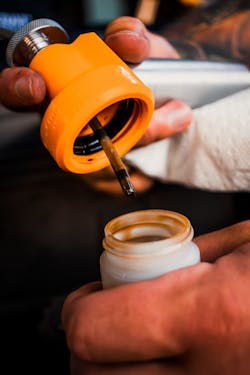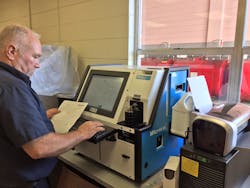While a dipstick offers technicians a few visual indicators about an engine’s oil—such as volume and viscosity, and if it needs to be changed—a properly executed engine oil analysis will provide valuable insights they cannot see. These insights can help fleets not just in the moment, but for a long time after. Data provided from such an analysis will provide a fleet maintenance manager the confidence to extend out drain intervals when conditions are favorable or take corrective action when issues like oxidation, contamination, or metal wear are discovered. This, in turn, keeps trucks on the road and technicians from chasing new problems.
But when to start?
Steve Bowles, senior product specialist for lubricants at Citgo Petroleum, said it is wise to begin regular sampling after the first couple of oil changes.
“It’s important to establish a baseline,” Bowles said. “Oil analysis is largely based on historical trends. Once you have a baseline, you can start to see when things are climbing or going down, alerting you to the fact that something is going on.”
Once a vehicle is through its initial break-in period, an efficient approach is to draw an oil sample at every oil change. Bowles said some fleets choose to do it even more frequently.
Whatever the case, consistency is the key.
Read more: How to properly execute a used engine oil analysis program
Mastering the collection method
There are a few ways to collect an engine oil sample.
“Whichever method you’re using, it’s always important to clean the surface around where the sample is being taken,” Bowles said. “You also want to take a sample after the engine has been running for 15 to 30 minutes. That way, the oil is still hot and representative of what it’s like inside the engine.”
A common method is to use a vacuum pump and go in through the dipstick tube. Though far less common and typically not recommended, a technician could also take the sample out of the drain port.
“If you take your sample when the oil is being drained, wait at least five seconds before catching it midstream,” said Karin Haumann, OEM technical services manager for Shell Lubricants. “That way you won’t be collecting heavy metals or other deposits lying at the bottom of the pan.”
Some fleets choose to install an oil sampling valve. Products like the KP Pushbutton from Checkfluid can help save time while enhancing the consistency.
“A pushbutton valve with a built-in probe takes a lot of the potential variability away,” said Bernie Hall, general manager of Checkfluid. Since the probe is built into the valve and the valve stays on the engine, there is less risk of cross contamination.
Once a valve is installed, the technician simply pushes a button to draw a sample into a bottle.
“Be sure to thoroughly purge the sample valve and related tubing prior to filling the oil sample container,” noted Darryl Purificati, Sr., technical advisor, OEM/automotive for Petro-Canada Lubricants, an HF Sinclair brand. “Also confirm that the sample container has been kept clean prior to taking the sample.”
First, a fleet has to install the valve. Predetermining where to install the valve helps ensure that the right valve and thread type are chosen. Valve manufacturers like Checkfluid can provide guidance. Fleets could also look to their lubricants providers for advice.
Purificati said it’s a good idea to install a sampling valve after the engine oil pump, but before the oil filters. Then it comes down to personal preference and the technician’s quest for efficiency.
“With a good plan in mind and a bit of wrench turning, you’re typically looking at a 15-minute install, at the most,” Hall said. Sometimes a “remote access solution” is needed, which involves routing a high-temperature hose from the engine port to a location where the valve can be more conveniently mounted.
“With a properly installed sampling valve, it might take a technician a couple of minutes from start to finish to take a good sample,” Hall said. “Using a vacuum pump might take 15 or 20 minutes.”
That doesn’t mean a vacuum pump can’t be an effective method, too. The key is making sure it is used correctly.
Ryan Stark, president of Blackstone Laboratories, a provider of oil analysis programs and products, said the tube should be inserted slightly past the head in the pump. This helps ensure that the oil goes directly from the tube into the bottle, avoiding a mess the technician has to clean up. It’s also important to draw the sample in a controlled fashion so the bottle isn’t overfilled. According to Stark, the typical technician won’t need more than a few minutes of training to get the hang of it.
Stark also said it’s important to make sure the tubing is clean to avoid cross contamination between samples. Some fleets choose to use new tubing every time. Stark said that should not be a deterrent to using a vacuum pump.
“The 1/4-inch tubing is inexpensive and readily available at any hardware store,” Stark pointed out. “But I don’t think you necessarily need to change it every time. I drain my tubing at home into a paper towel and just reuse it. In my mind, the risk of cross contamination is minimal if all the oil is completely drained out.”
Whichever collection method is used, a shop’s oil sampling processes should be geared toward one thing: consistency.
“It’s helpful when you can keep things as consistent as possible,” Citgo’s Bowles said.
If possible, have the same technician pull the sample each time. Also, be sure to draw the sample the same way and from the same location each time.
“Consistent samples lead to consistent results,” Bowles reminded.
No time to waste
As critical as it is to get it right, collecting a sample is just the first step. Fleets also need good processes around getting that sample analyzed. Time is of the essence when sending a sample into a lab.
“Any snags usually happen on the front end,” Bowles said. “Sometimes a technician wants to wait and send in 10 samples at once. But that doesn’t work if a couple of those samples have to sit around the shop for a couple of weeks. They can start to oxidize more if left in the sun, for example. Plus, if there is an issue going on with the engine, the fleet loses time in taking corrective action. With oil sampling, you want the results as quickly as possible. A good lab will usually knock it out in a day or two once they receive the sample.”
For that to happen, though, the technician needs to fill out all of the paperwork correctly.
“Information like vehicle ID, engine oil brand and viscosity, mileage, etc. is important to give to the lab,” Bowles said. “If the lab doesn’t get that information, there isn’t much they can do with the sample. The better the information you send in, the better the information you’ll get back.”
Read more: Best practices to optimize engine oil drain intervalsWorking with a good lab is also important. Bowles said a good indicator to look for when selecting a lab is an ISO/IEC 17025 accreditation for testing and calibration laboratories.
In certain instances, it might make sense for a fleet to consider bringing oil analysis in-house. We’re not talking about those test strips that cost one or two bucks apiece and check for the presence of coolant in fluids. Companies like Ametek Spectro Scientific manufacture high-tech fluid analysis equipment designed to bring the lab to the shop.
Bob Wopperer, senior director of business development for Ametek Spectro Scientific, said their most popular machine for fleets is the MicroLab 40 On-Site Oil Analyzer.
The acquisition cost is around $100,000. Thus, a fleet would want to consider the volume of oil samples it plans on testing, along with the other inherent benefits of bringing oil analysis in-house. Wopperer said most vehicle fleets using their equipment are maintaining several hundred vehicles.
One of the inherent advantages of in-house oil analysis is time savings. The technician draws a sample just like he or she would if working with a lab. But instead of having to package that sample and mail it to a lab, the technician simply sets it on the in-shop machine, attaches a sipper straw, enters a bit of information, and presses start. The technician can then get back to working on the vehicle while the machine runs its test, which Wopperer said takes 10 to 15 minutes.
Another benefit is having the ability to get immediate results and take immediate action. Even with the best processes in the world, a fleet will end up waiting at least a few days for results when mailing samples to a lab. With in-shop equipment, a thorough report with maintenance recommendations is just minutes away.
Whether working with a lab or attempting to run an oil analysis program entirely in-house, Petro-Canada’s Purificati said many fleets feel like they simply don’t have the time. Others lack confidence in their ability to interpret the data.
“We always recommend seeking advice from a lubricants expert, like a technical service advisor, who can use their expert insight and experience to provide analysis and highlight trends in a report’s findings,” said Purificati, who is also the current chair of the American Petroleum Institute’s lubricants committee.
Speaking of reports, Purificati said the best labs and technical advisors will take advantage of digital diagnostic tools that provide 24/7 access to reports and data. This adds further value for a fleet.
“Digital oil diagnostics can help fleets stay one step ahead, proactively tracking where maintenance is needed while making predictions about where it will be needed in the future,” Purificati said. That, in essence, is what good engine oil analysis and preventive maintenance in general is all about.
About the Author

Gregg Wartgow
Gregg Wartgow is a freelancer who Fleet Maintenance has relied upon for many years, writing about virtually any trucking topic. He lives in Brodhead, Wisconsin.



